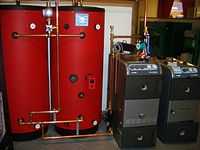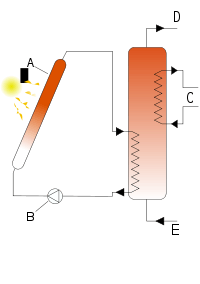Hot water storage tank



A hot water storage tank (also called a hot water tank, thermal storage tank, hot water thermal storage unit, heat storage tank and hot water cylinder) is a water tank that is used for storing hot water for space heating or domestic use. A heavily insulated tank can retain heat for days.[1] Hot water tanks may have a built-in gas or oil burner system, or electric immersion heaters, or may use an external heat exchanger to heat water from another energy source such as a wood-burning stove or a district heating system.
Water is a convenient heat storage medium, because it has a high specific heat capacity. Compared with other substances it can store more heat per unit of weight (and volume). Water is non-toxic and in many countries available free of charge or at low cost.
Water heaters for washing, bathing, or laundry have thermostat controls to regulate the temperature, in the range of 40 to 60 °C, and are connected to the domestic cold water supply. Where the water supply has a high content of dissolved minerals such as limestone, heating the water causes the minerals to precipitate in the tank; a water tank may develop leaks due to corrosion after only a few years. Dissolved oxygen in the water can also accelerate corrosion of the tank and its fittings. A hot water storage tank is wrapped in heat insulation to reduce heat loss and energy consumption.
Insulation
In general, the more thermal insulation the better, since it reduces standby heat loss. Water heaters are available with insulation ratings ranging from R-6 to R-24. It may be possible to add an extra insulating blanket or jacket on the outside of a poorly insulated water heater to reduce heat loss. The most common type of water heater blanket is fiberglass insulation with a vinyl film on the outside. The insulation is wrapped around the tank and the ends are taped together. It is important that the blanket be the right size for the tank and not block air flow or cover safety and drainage valves, the controls, or block airflow through the exhaust vent, if present. In very humid locations, adding insulation to an already well-insulated tank may cause condensation leading to rust, mold, or other operational problems.
Modern water heaters have polyurethane foam (PUF) insulation. In countries where serviceability is very important, PUF capsules are kept between the inner tank and the outer body.
Solar hot water storage tank
In a solar water heating system, a solar hot water storage tank stores heat from solar thermal collectors.[2] The tank has a built-in heat-exchanger to heat domestic cold water. These tanks have the same problems with limestone deposit and corrosion as non solar heated tanks, which reduce the efficiency of the heat exchanger.
Water tank leakage
Water heater tanks may be made of vitreous enamel-lined carbon steel, stainless steel, or copper. Vitreous-lined tanks are much lower in initial cost, and often include one or more sacrificial anode rods designed to protect the tank from perforation caused by corrosion.[3] Such protection is necessary since chlorinated hot water is very corrosive to carbon steel, and it is nearly impossible to apply any protective coating perfectly, without small cracks or pinhole defects in the protective layer.[4] Manufacturers may recommend checking the sacrificial anode rod periodically and replacing it when necessary; some manufacturers offer an extended warranty kit that includes an additional anode rod. Common practice in the US is to neglect this maintenance until the tank develops a leak, and then to replace the entire appliance.[5] Even when neglected, carbon steel tanks tend to last for a few years more than their manufacturer's warranty, which is typically 3 to 12 years in the US.
Because conventional hot water storage tanks can be expected to leak every 5 to 15 years, high-quality installations will include, and most US building/plumbing codes now require, a shallow metal or plastic pan to collect the inevitable seepage when it occurs. Such a pan should be connected to a drain, or plumbed to discharge directly outdoors. When this is difficult or impossible, an alternative precaution to reduce flood damage is to place some sort of water alarm on the floor near the water tank, possibly connected to an automatic water shutoff valve.
Water heater tanks should be installed with physical access in mind, both for inspection and replacement of the long anode rod, and for eventual replacement of the entire tank.[6] With regards to repairing leaks in hot water storage tanks, it is generally accepted by plumbers and specialists that any leak from the bottom of the tank will require total replacement of the unit (i.e., it is unrepairable). However, if the leak is coming from in or around the pipes or taps on the storage tank, then repair is an economically feasible option.[7]
Hot water storage tank with closed water circuit
Another method to store heat in a hot water storage tank is to heat the water directly in one (or more) heat sources via external heat-exchangers. The heat can later be tapped again to hot water or heating via external heat-exchangers.
The good thing about avoiding sending domestic cold water directly into the hot water storage tank is that only a little limestone is deposited when water is replenished in the closed water circuit.
Another good thing is that the hot water storage tank water only seldom is added domestic cold water with oxygen, which relaxes the materials choices for the hot water storage tank and closed water circuits.
The external heat-exchanger used for domestic hot water will have limestone deposits and for that reason need to be exchanged or use some benign descaling agent from time to time, but this is cheaper than exchanging the hot water storage tank.
Stratified hot water storage tank with closed water circuit
- For an illustration - see reference[8]
Another method to store heat in a hot water storage tank is as above, but with some important changes. It has many names: Stratified hot water storage tank with closed water circuit, stratified thermal storage, thermocline tank and water stratified tank storage.
The important changes are as follows. Water mixing within the hot water storage tanks vertical water column must be minimized. These water layers typically have different temperatures. The purpose is to maintain the vertical stratification of the water column. This is achieved by:
- The different heating and cooling loops must send the heated or cooled water in with as low velocity as possible.
- This means that the heating and cooling loops each must have a velocity controlled pump - and the tube ports must have as big inner diameter as is feasible.
- For cooling applications, cool water is sent out from the bottom and the heated water is returned to the top.
- Heating applications get hot water out at the top and return cool water to the bottom.
- There can be "stratification-enhancing"-devices within the hot water storage tank, but if it the water inlet velocity is as low as possible this might not be needed.
- A more advanced heat control system[9] must be used.
When a stratified hot water storage tank has closed water circuits, the water temperatures can be up to 90...95 °C at the top - and e.g. 20...40 °C at the bottom.
Calm and undisturbed water is a relatively poor heat conductor when compared to glass, bricks and soil. This is illustrated by a lake, where the surface water is warm but deeper layers are cooler. An arbitrary volume of hot water can be stored, as long as the stratification is kept intact. No vertical metal plates or tubes may be used inside the hot water storage tank, because this would conduct heat between the stratified layers. The hot water storage tank is insulated.
The advantage is that water can be stored at 90...95 °C in this hot water storage tank type, giving a higher energy density, and this energy can be stored a long time if the hot water is not diluted.
Optimizing water exchanges can allow different levels to be tapped within the tank, matching temperature to the required use. [8]
A practical solar heating system with many parameters can be read as a function of time - incl. the hot water storage tank temperature near the top.[1]
Dual element electric
When flow starts from the top outlet, cold water enters to the bottom. This temperature drop switches the thermostat and element on at the bottom. When the water at the top of the tank is displaced by cooler water, the top thermostat and element turn on. When the flow stops, the elements stay on until their settings are met.[10] It is common to have the top and bottom thermostats set differently, in order to save energy. If they are set 'backwards' it may affect the efficiency.
References
- ↑ 1.0 1.1 invest-tools.com: Graphs, Main page and description: Overview of the DHW system, The water tank (heat reservoir) Quote: "...With the tank there came a 10 cm "soft foam" isolation that fulfills the minimum insulation requirements...So after several months, I added another round of 16 cm aluminum coated glass wool, and now the tank stores enough heat for about 7 or 8 days when it is full loaded (temperature range is 95°C down to 40°C)..."
- ↑ .Brian Norton (2011) Solar Water Heaters: A Review of Systems Research and Design Innovation, Green. 1, 189–207, ISSN (Online) 1869-8778
- ↑ Schuyler, Randy. "The Basics: Anodes and Longevity". Water Heater Rescue. waterheaterrescue.com. Retrieved 2012-03-31.
- ↑ Schuyler, Randy. "The Basics: Choosing a water heater". Water Heater Rescue. waterheaterrescue.com. Retrieved 2012-03-31.
- ↑ Schuyler, Randy. "The Basics: What kills water heaters". Water Heater Rescue. waterheaterrescue.com. Retrieved 2012-03-31.
- ↑ Schuyler, Randy. "The Harry Houdini Memorial Showcase". Water Heater Rescue. waterheaterrescue.com. Retrieved 2012-03-31.
- ↑ Rankin, Chris. "How Do I Know Whether I Need A New Hot Water Cylinder?". Cylinder Guy. cylinderguy.co.nz. Retrieved 2014-09-16.
- ↑ 8.0 8.1 Solar heating system with stratified hot water storage tank with closed water circuit and the possibility of reading many current parameters: solar.webseiten.cc: Live-Daten Holzhausen
- ↑ Technische Alternative: Freely programmable universal controller UVR1611, Manuals and firmware in english and german: downloads, Programing examples: UVR-Beispielsammlung, Practical examples on solar heating systems with hot water storage tanks with current measuring date: Livedaten
- ↑ "How It Works: Water Heater". Popular Mechanics. Retrieved 26 November 2014.